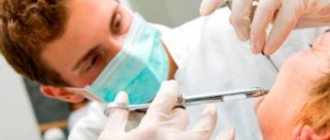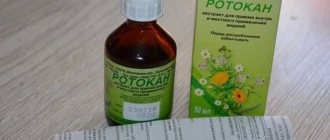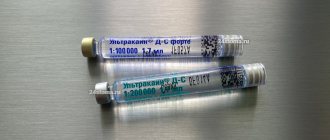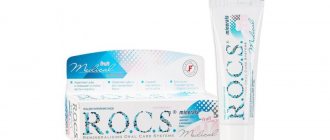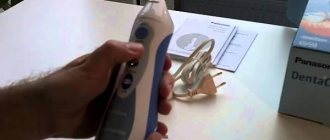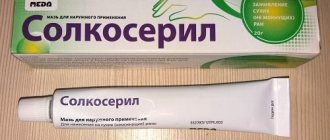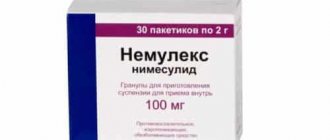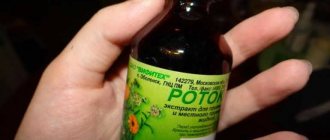N-Light Medical Center provides a unique service for the treatment of gum disease of any degree latest generation diode laser GRANUM. This service allows patients to undergo a painless and effective course of treatment for periodontitis, gingivitis and periodontal disease in Dnepropetrovsk. We also offer alternative methods for treating these diseases.
Periodontal diseases
Literal translation from Greek, periodontitis means “near the tooth” or, in other words, an inflammatory process in periodontal tissues. The periodontium includes not only the gums, but also bone tissue, jaws and muscles.
Periodontal symptoms
- Bleeding gums
- Tooth mobility
- Redness of the gums
- Peeling of tissue from teeth
- Bad breath
- Itchy gums
- Increased tooth sensitivity
There are many causes of gum disease. The health of the gums affects the overall health and condition of the entire body. Also, the inflammatory process can be caused by insufficient oral hygiene, dental plaque, malocclusion, little or no solid food intake, which leads to a decrease in the load on the teeth. Periodontal disease is one of the most common causes of tooth loss.
There are three types of periodontal disease
- Periodontitis
- Gingivitis
- Periodontal disease
Gingivitis is a mild form of periodontitis. Gingivitis is a superficial inflammation of the gums around the tooth. With further spread of inflammation, microbes penetrate deep into the tissues, where periodontitis then develops.
Periodontitis is a consequence of untreated gingivitis. With this disease, there is destruction of the tissues that attach the tooth to the bone. As a result, so-called “periodontal pockets” appear. Many germs accumulate in these pockets, which can even lead to tooth extraction or loss.
Periodontal disease, unlike gingivitis and periodontitis, which are related to each other, is extremely different. Periodontal disease is not an inflammatory disease; it is caused by age-related changes in humans. The gums, on the contrary, look healthy and fit tightly to the teeth. With periodontal disease, the height of the gums gradually decreases, the necks of the teeth and maybe even the roots are exposed. This is all explained by the fact that in old age, blood supply to the periodontal tissues deteriorates, blood vessels narrow, and metabolic processes are reduced. All this gradually leads to atrophy of the gum tissue, and subsequently tooth loss.
Qualified doctors of our dentistry will help with the treatment of periodontal disease, gingivitis and periodontitis in Dnepropetrovsk. The innovative technologies of our clinic and the professionalism of our doctors allow us to find the cause of these diseases and provide you with a range of treatment until complete recovery.
- Prices
- Stock
- Reviews
Prices for the procedure Treatment of periodontitis
| Treatment Options | Price |
| Using injections with traumeel, lincomycin, vitamins | 1 injection from 150 UAH |
| With laser | from 500 UAH |
Special offers
Promotions for this service are temporarily unavailable
Advantages and disadvantages of local treatment for bleeding and periodontal disease
Injections into the gums are designed for rapid delivery of medicinal substances to hard tissues. Aimed at eliminating the root cause of periodontal disease at the initial stage of the disease, namely bleeding. For injections into the gums, special syringes with the thinnest possible needle are used. They reduce pain and make the procedure minimally traumatic. Benefits of injections into the gums:
- strengthening gums during periodontal disease;
- improvement of metabolic processes;
- treatment and prevention of inflammatory processes in the gums;
- strengthening local immunity;
- restoration of the natural microflora of the oral cavity.
Injections into the gums should only be done by a dentist. Possible disadvantages of this method of therapy:
- can only be used in the initial stages, when the hard gum tissue is not irreversibly damaged;
- sometimes complications occur if the injection is given incorrectly or the oral cavity is not disinfected;
- people with hypersensitivity may experience severe discomfort;
Proper preparation and, if necessary, pain relief with local anesthetics will help to avoid problems.
Other oral diseases are a contraindication to injection therapy for periodontal disease. They need to be treated first to avoid complications.
Reviews about Lincomycin
Reviews of Lincomycin that users leave online indicate that this drug has a pronounced antimicrobial effect and allows you to quickly get rid of the unpleasant symptoms of infectious diseases. Those who have used Lincomycin injections also leave mostly positive reviews.
Both when administered intravenously and intramuscularly, the solution acts quickly and reduces the severity of symptoms. Reviews about the use of the product in dentistry often contain information that the drug helped to quickly get rid of purulent and inflammatory diseases.
What tactics are used to treat periodontal disease?
I want to start with the fact that patients who come with a diagnosis of periodontal disease, they need, every single one, treatment... not from the periodontist to whom they initially turned.
If we talk about the tactics of managing patients with the so-called. periodontal disease, which then come to me again, it’s a shame to voice this, but the treatment of periodontal disease was carried out right up to injections of Lincomycin into the exposed gum.
According to statistics, almost always the treatment of periodontal disease in adults with medications is burdened with a course of some antibiotics and physical therapy.
And most importantly, the task of all these manipulations is completely unclear: what do doctors want to achieve in this way, to destroy some kind of flora or to stop some destructive processes in the gums? It is very difficult for me to say what happens to the competence of a doctor who injects antibiotics for the so-called. periodontal disease, but this is absolute blasphemy. Is it possible to cure periodontal disease by destroying the flora? As a result, the gums will never recover.
Treatment of gum periodontal disease reaches the point of absurdity
I would like to note the widest range of drugs and folk remedies that patients use to attempt self-treatment of periodontal disease at home. Among the folk remedies, one can note the treatment of periodontal disease with hydrogen peroxide, and even treatment with soda:
What about the use of various toothpastes for periodontal disease? What goals do patients have? The purpose of toothpaste is preventative, not curative. And no toothpaste will eliminate inflammation, because there is no such inflammation in periodontal disease.
It is not difficult to guess that in these combinations of procedures the question of how to cure periodontal disease remains open.
Side effects
When using Lincomycin in ampoules and capsules, patients may experience the following side effects:
- dysfunctions of the gastrointestinal tract ( vomiting , pain, nausea , stool disorders, increased activity of liver enzymes, esophagitis , hyperbilirubinemia );
- disorders of the hematopoietic process ( thrombocytopenia , agranulocytosis , neutropenia , pancytopenia );
- allergic processes ( skin itching , urticaria , rash , swelling erythema multiforme , anaphylactic shock );
- muscle weakness, headaches , arterial hypertension , dizziness .
If you experience any side effects, you should immediately tell your doctor about it.
What antibiotics are needed for dental treatment?
Antibiotics for dental treatment are prescribed for inflammation of the bone tissue or the segment surrounding it.
- An abscess is a commonly diagnosed inflammation of a tooth. Antibiotics are prescribed for gingival (flux), periodontal or peripical localization of infection. The cause of an abscess is the penetration of bacteria into the tooth pulp.
- Antibiotics are prescribed to treat teeth affected by pulpitis . In this case, only soft tissues are affected and there is no inflammation of the tooth root. The antibiotic helps with acute pain, sensitivity to temperature, swelling and other symptomatic manifestations of pulpitis.
Antibiotic therapy in dentistry is provided for all infectious pathologies: necrotic process, sepsis, inflammation of the tooth root. Antibiotics are prescribed in courses in the form of tablets, injections, ointments and solutions for applications.
Indications for use of Lincomycin
Lincomycin tablets and Lincomycin injections are prescribed for the following diseases:
- diseases of the bones and joints of an infectious nature, the development of which was provoked by microorganisms sensitive to the drug ( osteomyelitis , septic arthritis );
- infectious diseases of the ENT organs and respiratory tract, provoked by sensitive microorganisms (used for sore throat , sinusitis , otitis , bronchitis , pneumonia , tracheitis , etc.);
- diseases of the skin and soft tissues, which are provoked by microorganisms sensitive to the product ( abscess , purulent wounds , mastitis , furunculosis , erysipelas , etc.).
- Lincomycin-AKOS is used externally for inflammatory and purulent diseases of soft tissues and skin, which were caused by microorganisms sensitive to the active ingredient.
Lincomycin is used in dentistry to treat purulent and infectious processes that occur in the oral cavity. In particular, Lincomycin in dentistry can be prescribed for the treatment of periodontitis , periodontitis , gingivitis , purulent abscesses , etc. Whether there are indications for the use of Lincomycin is determined by the dentist individually.
How to determine periodontitis?
It is indicated by bleeding, soreness and darkening of the gums, their swelling and itching. Another undoubted sign is loose teeth and their subsequent loss.
Progressive periodontitis is easily distinguished by bad breath and noticeable exposure of the neck of the teeth and the appearance of pus. Such a lesion can conditionally be called advanced gingivitis, and if the gums are not treated in a timely manner, periodontitis can develop into periodontal disease.
The cause of periodontitis is a newly formed “pocket” that appears between the tooth and the gum. Food debris and plaque accumulate in it; this accumulation causes an inflammatory reaction and itching.
Lincomycin price, where to buy
The price of Lincomycin in ampoules averages from 40 rubles for 10 ampoules of 1 ml.
The price of Lincomycin tablets ranges from 60 to 90 rubles for 20 pieces. You can buy the drug in capsules in Ukraine for an average of 25 UAH. (30 pcs.).
Lincomycin-AKOS ointment can be purchased at a price of 27 rubles.
- Online pharmacies in RussiaRussia
- Online pharmacies in UkraineUkraine
- Online pharmacies in KazakhstanKazakhstan
ZdravCity
- Lincomycin capsules 250 mg 20 pcs. Medicine production LLC
72 rub. order - Lincomycin capsules 250 mg 20 pcs. Ozon LLC
126 rub. order
- Lincomycin hydrochloride solution for injection. 30% 1ml 10 pcs. JSC Dalkhimfarm
116 RUR order
Pharmacy Dialogue
- Lincomycin hydrochloride (amp. 30% 1 ml No. 10) DHF JSC
88 rub. order
- Lincomycin hydrochloride (amp. 30% 1 ml No. 10) Belmedpreparaty
80 rub. order
- Lincomycin h/x (caps. 250 mg No. 20)Production of medicines
66 RUR order
- Lincomycin (caps. 250 mg No. 20) Belmedpreparaty
65 rub. order
show more
Pharmacy24
- Lincomycin-Darnitsa 30% 1 ml No. 10 solution
37 UAH. order - Lincomycin KMP 250 mg N30 capsules PAT "Kievmedpreparat", Ukraine
35 UAH order
- Lincomycin-Darnitsa 30% 2 ml No. 10 solution for injection
54 UAH order
- Lincomycin 300 mg/ml 1 ml No. 10 solution TOV" Pharmaceutical company "Zdorovya", Kharkiv, Ukraine
34 UAH order
- Lincomycin 0.25 N20 capsules PAT NEC "Borshchagivsky chemical-pharmaceutical plant", Kiev, Ukraine
32 UAH order
PaniPharmacy
- Lincomycin capsule Lincomycin capsules 0.25g No. 30 Ukraine, Kievmedpreparat OJSC
42 UAH order
- LINCOMYCIN ampoule Lincomycin solution for injection 30% ampoule 1 ml No. 10 Ukraine, Health LLC
35 UAH order
- Lincomycin ampoule Lincomycin solution for injection 30% ampoule 1 ml No. 10 Ukraine, Darnitsa ChAO
41 UAH order
- LINCOMYCIN ampoule Lincomycin solution for injection 30% ampoule 2ml No. 10 Ukraine, Health LLC
53 UAH order
- Lincomycin ampoule Lincomycin solution for injection 30% ampoule 2ml No. 10 Ukraine, Darnitsa ChAO
56 UAH order
show more
Causes of gum disease
The main cause of gum disease is poor oral hygiene. The processes of periodontal destruction begin at the moment of formation of a dental film of bacteria and the accumulation of soft dental deposits. If you do not remove all the bacteria in your mouth by brushing your teeth at this point, tartar will form.
In turn, the formation of stone on the teeth will lead to the formation of a periodontal pocket. In the absence of treatment, bone loss and destruction of the musculoskeletal system of the tooth occurs. This leads to exposure of tooth roots, loosening and loss of teeth.
Antibiotics
Since the treatment is based on an antimicrobial method, taking antibiotics is inevitable for this disease. For periodontal disease, broad-spectrum antibiotics are usually prescribed, as they can destroy the maximum number of pathogenic bacteria.
Before starting treatment with tablets, it is necessary to do a special bacterial test to determine the sensitivity of bacteria to the prescribed antibiotic. If the patient does not tolerate antibiotics well, the doctor needs to find an alternative method of treatment. That is why it is strictly forbidden to self-medicate and prescribe medications on your own.
Modern antibiotics come in various forms. It can be:
- tablets for oral administration;
- capsules for systemic treatment;
- gels for local use;
- special antiseptic solutions for rinsing the mouth.
Antibiotics may also be present in medicated toothpastes intended for the treatment of periodontal disease.
Despite such a variety of dosage forms, antibiotics are most effective in the form of tablets and capsules for internal use. In this case, they influence the entire body, allowing you to achieve maximum effect.
Most often, when treating periodontal disease, dentists prescribe the drugs metronidazole and doxycycline . They act specifically on those microorganisms that cause the disease. In combination with chlorhexidine, these drugs can almost completely get rid of the symptoms of periodontal disease.
Lincomycin
In recent years, treatment of periodontal disease with lincomycin has become increasingly common. This is a new generation antimicrobial drug with a broad spectrum of action. Lincomycin has a bactericidal effect.
Lincomycin is also prescribed in the presence of infectious diseases of the joints, bones (arthritis, osteomyelitis), respiratory tract (pharyngitis, tracheitis, pneumonia, bronchitis, sinusitis), soft tissues and skin (furunculosis, abscess, erysipelas, mastitis). The therapeutic dose is set by the doctor, depending on the patient’s condition and the severity of the disease in each specific case.
Usually this drug is taken for up to two weeks, but in exceptional cases the duration of use can be extended. Under no circumstances should you self-prescribe lincomycin! At a minimum, you can “earn” dysbacteriosis, and at a maximum – serious damage to the kidneys and liver. Therefore, treatment with lincomycin should be carried out only as directed by a dentist, who will select an effective and at the same time safe dose of the drug.
Trichopolum
The modern antimicrobial drug trichopolum is often used for periodontal disease. Trichopolum is also a broad-spectrum antibiotic, so it is used not only in dentistry. In particular, Trichopolum is prescribed for amoebiasis, trichomoniasis, giardiasis, vaginitis, urethritis, infectious diseases of bones, joints, central nervous system, bacterial pneumonia and other diseases.
Since Trichopolum has a wide spectrum of action, it effectively fights all known bacteria that are involved in the occurrence of the disease. Therefore, you should not be alarmed if the doctor prescribes you this particular antibiotic - it is used not only in general therapy, but also in the treatment of dental diseases, which include periodontal disease.
Pharmacokinetics and pharmacodynamics
After oral administration, lincomycin hydrochloride is rapidly absorbed from the gastrointestinal tract. About 50% of the substance enters the systemic circulation. It is 75% bound to plasma proteins, the highest concentration is observed 2-4 hours after oral administration. The substance penetrates into fluids and organ tissues. The highest concentrations are observed in saliva, kidneys, genitals, liver, heart muscle, bone tissue, and bronchial secretions. Able to penetrate the blood-brain barrier, it is excreted in breast milk. Metabolism mainly occurs in the liver, it is excreted from the body in feces, a small amount is also excreted in the urine as metabolites and unchanged. The half-life from the body is 5-6 hours, it increases in people suffering from kidney disease.
Types of injections
Treatment of periodontal disease is carried out in a complex manner, so the dentist may prescribe several different types of injections at the same time. There are 7 varieties in total:
- Immunomodulators. These drugs help the body resist the disease, as they produce specific antibodies that suppress pathogenic microorganisms. Immunostimulating drugs can be of animal, plant or chemical origin. Injections with such medications allow you to relieve the inflammatory process and cure periodontal disease in a minimum period of time.
- Vitamin complexes. To boost immunity and enhance recovery functions, the doctor may prescribe a complex of vitamin injections B1, B2, B6, B12, as well as vitamin C.
- Biostimulants. The synthetic drug FiBS is prescribed in the presence of an inflammatory process in periodontal tissues. Thanks to it, a chain of cascade reactions is launched in the body, as a result of which metabolism accelerates. The course of treatment with this drug is 30 injections in the upper and lower jaws. At the same time, injections of nonspecific effects, for example, Metacil, Biosed, etc., can be prescribed. Aloe extract can also work as a biogenic stimulant.
- Sclerosing injections. They are used for swelling and hypertrophy of the gums. Before the procedure, professional oral hygiene is required. After this, chromium alum and urethane quinine are injected deep into the gums. After a course of such injections, new tissue is formed and the mucous membrane is strengthened.
- Glucose injections. If the stage of the disease is accompanied by purulent inflammation, then deep sclerosis of the gums is carried out using a painless injection of glucose. It reduces swelling and improves the condition of the gums.
- Serum Filatov. If the inflammatory process is in the acute stage, then injections with blood products are given. Filatov's serum is administered intramuscularly up to 10 times.
- Medicines that saturate the body and gums with oxygen, for example, lidase.
LINCOMYCIN (solution)
Having “tested” these procedures on myself, I decided to try this procedure.
For injections, special syringes are required - “insulin”, I had to purchase them at the pharmacy. The drug itself was available at the dental clinic.
Let me tell you right away that the injection is very, very painful. The first time they did it on me was with a painkiller and it was quite painful. The second and third time, I already knew the pain level, so I was mentally prepared and endured. Although I had to wait just a few seconds. The injection was injected 4 times into the lower jaw and twice into the upper jaw. If you cannot stand the pain, ask for painkillers.
After the injection, you feel a little dizzy from pain. Therefore, I recommend sitting for a couple of minutes and not getting up. Within an hour or two, swelling of the lips and face is possible, small, but visible from external signs. Therefore, I don’t recommend going for a walk; it’s better to go home.
Before deciding on this procedure, I read about the drug “Lincomycin.” Even on Otzovik there was a sharply negative attitude towards him. Many authors criticized and wrote that there was no result, only side effects. However, this procedure was recommended to me by a dentist friend of mine, who was always honest with her patients. Yes, yes, there is such a doctor. I was surprised myself, she is retired and work is a hobby for her at the moment. She is paid well, regardless of the amount of work, so she does not impose unnecessary procedures. So, Reviewer users responded negatively and wrote that there was severe diarrhea after use, but there was no result. My friend, who recommended this injection, also treated her gums with lincomycin. She said it was really weakening him. However, I didn’t have any side effects or bowel disorders. I think everything is individual.
I really want to show you the before and after photos. The photographs do not quite convey the real picture, since I was not able to take them of high quality. However, even with them the result is noticeable. And visually it is obvious.
I also apologize for the unaesthetic photos. But I think they are needed for the plausibility and clarity of the result.
So, the course of treatment is 3 times every 3 days.
"Before" photo. The gums are very inflamed, bright red, I would even say burgundy, they do not bleed much, the gum pockets are swollen and loose. And this despite the fact that 8 months ago I treated them with ultrasound.
After 1 injection. The gums tightened up a little and became less swollen and inflamed. After just one injection.
After 2 injections. The lower gums are “almost healthy.”
After 3 injections.
Lincomycin has the ability to accumulate in bone tissue. Therefore, even after 3 procedures, after some time the noticeable result will increase. As the doctor told me, for young people one course is enough, for older people repeated treatment is necessary after 6-8 months.
I highly recommend this procedure and drug. The gums need to be treated. It turns out that I spent a lot of money for a pacifier. The injections cost me:
- 50 rubles * 3 injections = 150 rubles, -10 rubles * 3 = 30 rubles syringes, - 250 rubles consultation.
Total: 430 rubles. And for a course of treatment in the form of cleaning gum pockets, applications and medical treatment of gums, I paid 12-15 thousand rubles.
Do not believe reviews that say that lincomycin does not help treat gums. My example is illustrative.
I recommend everything. be healthy!
How to get rid of periodontal disease; gums have been bleeding for 5 years
- Log in to reply to this topic
#61
Yeah, so for periodontal disease, you need to be treated every six months with injections, and the injections are vitamins with painkillers
- Top
#62
- To your board
- 3,282 messages
- Top
#63
- Top
#64
Post has been edited by Falsetto: 01/06/2009, 16:59:09
- Top
#65
underwent vector treatment for Tchaikovsky-Nauryzbay Batyr. It helped for 2 weeks. again everything is new.
- Top
#66
- Top
#67
I've had a similar problem for several years now. I tried a lot.
In March I was injected with lincomycin - 5 days, 2 injections per day. terribly painful injections and some kind of Soviet drug.
but so far everything is fine for a month. It bleeds a little in one place, but I either brew oak bark or apply ointment.
I brush my teeth only with forest balm!
- Top
special instructions
If the patient has impaired renal or liver function, the single dose of the drug is reduced by 1/3-1/2, and the interval between administration is increased. With prolonged antibiotic treatment, the condition of the liver and kidneys must be monitored.
If the patient has renal or liver failure, the drug is contraindicated, for which Lincomycin can be prescribed exclusively for health reasons.
If a patient is prescribed Lincomycin tablets, which subsequently develops pseudomembranous colitis as a side effect, the drug is discontinued and Bacitracin or Vancomycin .
Externally, the ointment is carefully prescribed for dermatomycosis .
The solution should not be administered rapidly intravenously
